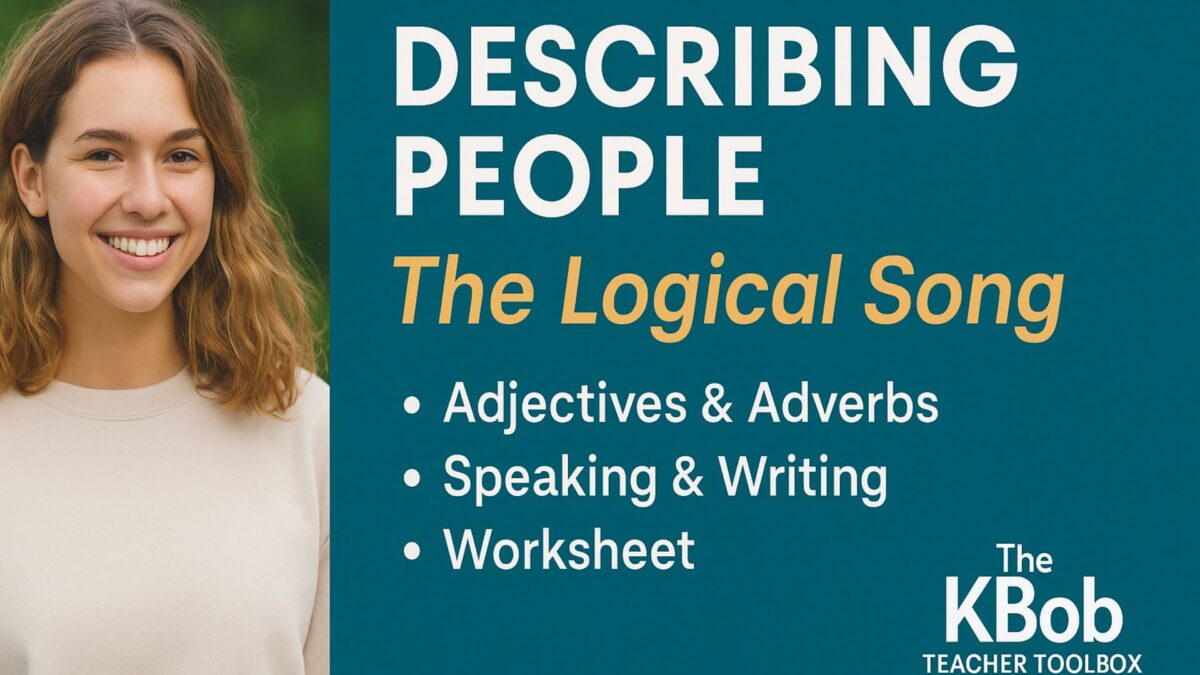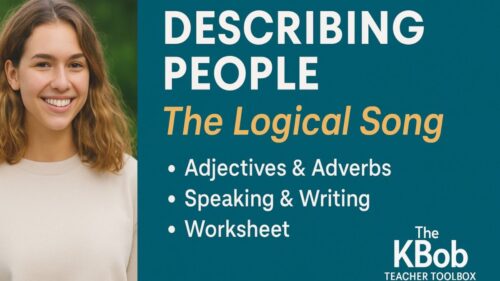Teach ESL learners to describe people using music, grammar, and speaking practice. Includes worksheet, video, and TPT lesson

Guess what? When you click and buy through our links, you’re doing more than improving your game. You’re supporting us in a way that doesn’t cost you extra but helps us keep bringing you the best drills and tips. It’s a slam dunk for both of us!
What do you get when you mix classic rock, real-world vocabulary, and a little grammar magic? A lesson your ESL students won’t forget! In this post, we’re exploring adjectives and adverbs through the legendary Supertramp song The Logical Song. This lesson works for high beginners and intermediate learners—and it’s designed to make students think, speak, and describe like never before.
Table of Contents
- What is a fun way to teach adjectives and adverbs to ESL students?
- What vocabulary helps describe people in English?
- How do we use adjectives and adverbs correctly?
- Can music help students speak English?
- Try this free worksheet sample
- Get the full lesson on TPT
What is a fun way to teach adjectives and adverbs to ESL students?
Use music, of course! The Logical Song by Supertramp includes more than 20 adjectives and adverbs. This is a great opportunity for students to learn descriptive words while also asking deeper questions about identity, expectations, and growth. We’ve included activities that explore meaning, pronunciation, grammar, and sentence structure.
What vocabulary helps describe people in English?
This lesson focuses on adjectives that describe people’s personalities, emotions, and behavior. Words like “happy,” “responsible,” “respectable,” “magical,” “fanatical,” and “acceptable” show up throughout the song. Students can identify these words and then use them in their own real-life sentences.
How do we use adjectives and adverbs correctly?
In this lesson, students review all 8 parts of speech but focus especially on adjectives and adverbs. They’ll learn that adjectives describe nouns, and adverbs describe verbs, adjectives, or other adverbs. The worksheets included help them categorize and use words like “logical,” “radical,” “playfully,” and “deep.”
Check out the table below:
| Part of Speech | Definition | Example from the Song |
|---|---|---|
| Noun | A person, place, or thing | life, miracle, criminal |
| Pronoun | A word that replaces a noun | I, me, they, you |
| Verb | An action or state | was, singing, learned |
| Adjective | Describes a noun | logical, wonderful, acceptable |
| Adverb | Describes a verb/adjective/adverb | so happily, playfully, absurd |
| Preposition | Shows relationship between things | at night, for such a man |
| Conjunction | Joins words or phrases | and, but, so |
| Interjection | Expresses emotion | oh, hey, yeah |
Can music help students speak English?
Absolutely!
After listening to the song and reviewing vocabulary, students complete a speaking role-play activity where they describe someone they know. Prompts are provided with fill-in-the-blank support and optional word banks, but students are encouraged to choose their own descriptive language.
They also participate in sentence building and short writing tasks, all scaffolded from the song lyrics and grammar practice. These integrated steps make the speaking activity much more natural.
Try this free worksheet sample
Get the full lesson on TPT
The complete 18-file lesson includes:
- Picture Dictionary (with real images, not cartoons!)
- Grammar Focus (adjectives, adverbs, all 8 parts of speech)
- Vocabulary Worksheet (based on the lyrics)
- Listening Activity with The Logical Song by Supertramp
- Speaking Role-play (describing someone you know)
- Short Writing Task (applying descriptive words)
- Quiz (12 questions – multiple formats)
- Wrap-up & Homework Sheet
View it now on TPT – Describing People + The Logical Song
This lesson was designed for high beginner and intermediate ESL learners but can be adapted for more advanced students as well. Whether you’re teaching in person or online, this no-prep resource is ready to go.
Final Thoughts + Additional Tools
Music connects emotion and memory—two things that are crucial for effective language learning. By using songs like The Logical Song, you can transform grammar and vocabulary lessons into meaningful conversations.
To take learning even further, I recommend pairing this lesson with a structured self-study program like Rocket Languages, or private conversation practice on italki. For structured, immersive listening, I also love EnglishClass101 and the gamified app Mondly Languages.
These are the same tools I recommend to my own students. Combine them with interactive lessons like this one and you’ll see measurable results in both fluency and confidence.
Have questions or ideas for using this song in your class? Leave a comment below or join us on Facebook to connect with other teachers.
I’d love to hear your thoughts. I always reply.


This is such a fun and creative way to learn English, Bob!
As someone who’s not a native English speaker, I find that music makes the learning process more enjoyable and memorable—especially when it comes to vocabulary and pronunciation. I really appreciate how you broke down the adjectives and adverbs in a way that’s easy to follow. I’m working on improving my English for more effective communication, and your lessons are both helpful and encouraging.
Looking forward to trying this method with my favorite songs!
Hi Alyssa, thanks for your comments. What is your first language? I’m glad you find my lesson helpful. My students like the music aspect too.
KBob